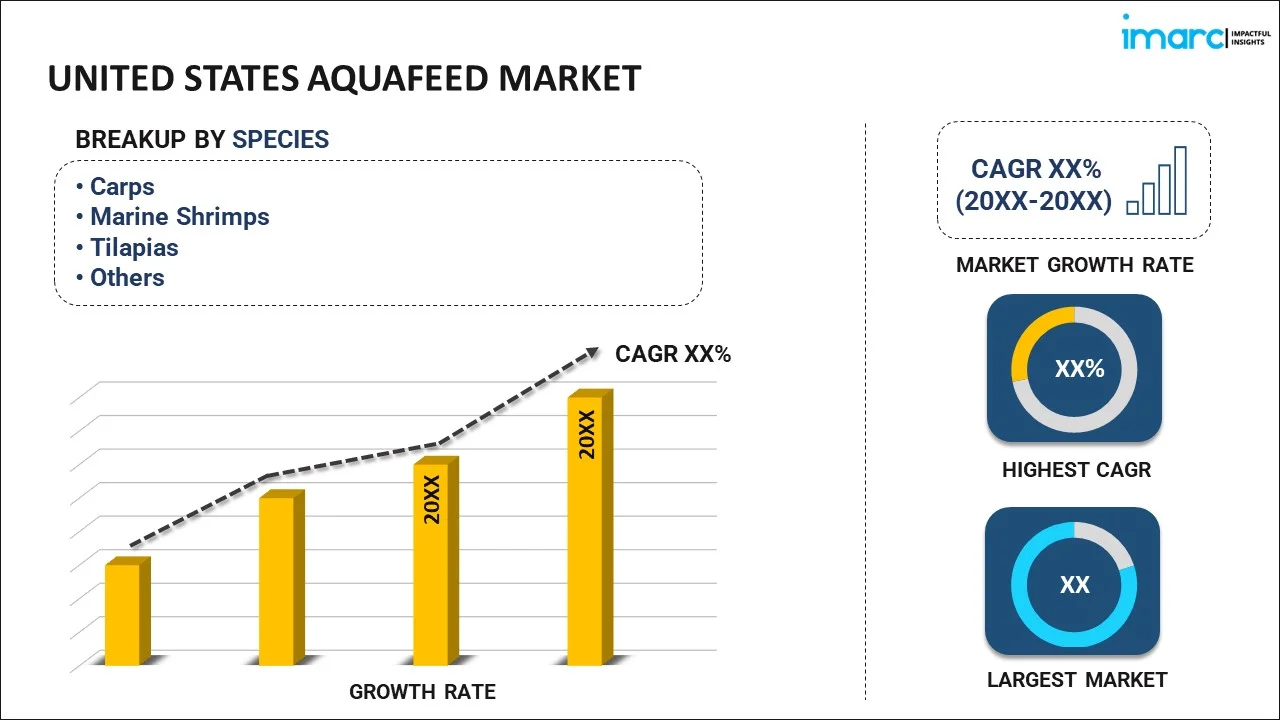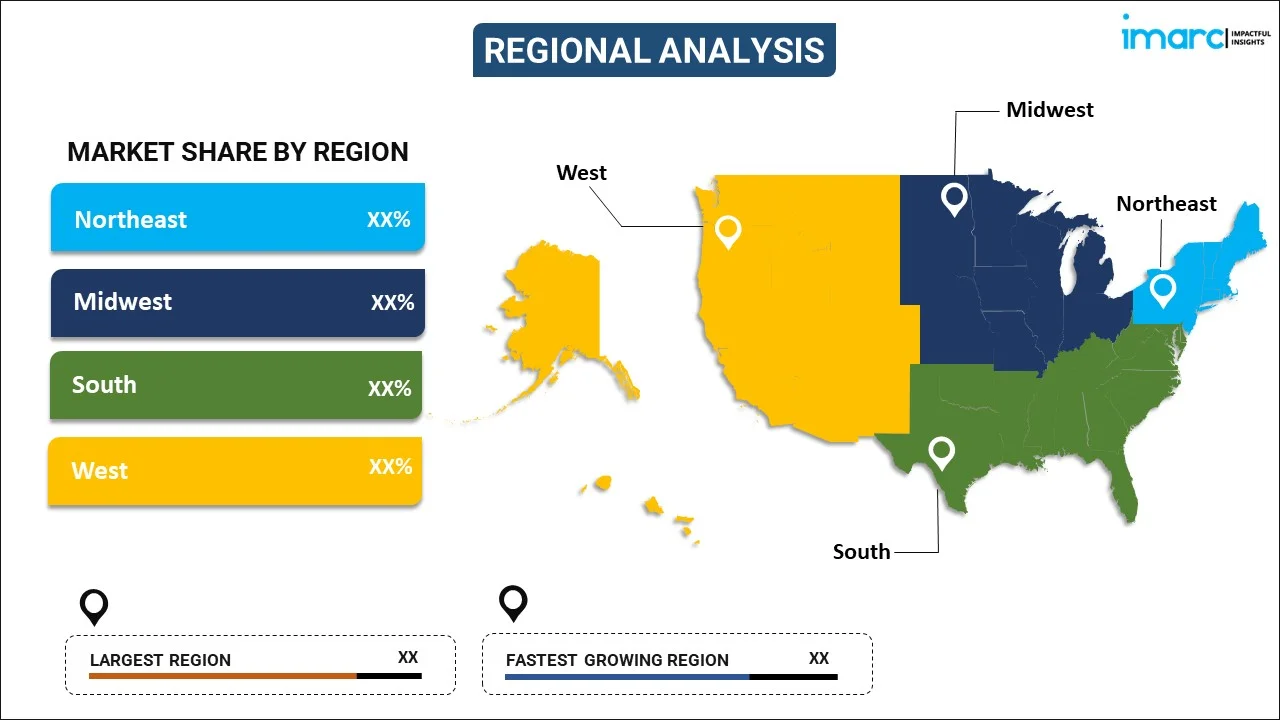
United States Aquafeed Market Report by Specie (Carps, Marine Shrimps, Tilapias, Catfishes, Marine Fishes, Salmons, Freshwater Crustaceans, Trout, and Others), Ingredients (Soybean, Corn, Fish Meal, Fish Oil, Additives, and Others), Additive (Vitamins and Minerals, Antioxidants, Feed Enzymes, and Others), Product Form (Pellets, Extruded, Powdered, Liquid), and Region 2025-2033
Market Overview:
The United States aquafeed market size reached USD 45,166.5 Million in 2024. Looking forward, IMARC Group expects the market to reach USD 67,191.1 Million by 2033, exhibiting a growth rate (CAGR) of 4.51% during 2025-2033. The increasing demand for seafood products in the United States, continuous research and innovation in aquafeed formulations, and the introduction of supportive policies and incentives for sustainable aquaculture represent some of the key factors driving the market.
|
Report Attribute
|
Key Statistics
|
|---|---|
|
Base Year
|
2024 |
|
Forecast Years
|
2025-2033
|
|
Historical Years
|
2019-2024
|
| Market Size in 2024 | USD 45,166.5 Million |
| Market Forecast in 2033 | USD 67,191.1 Million |
| Market Growth Rate (2025-2033) | 4.51% |
Aquafeed, also known as fish feed or aquaculture feed, is a specialized nutritionally balanced feed formulated to provide essential nutrients to aquatic organisms raised in aquaculture systems. Aquaculture refers to the farming of aquatic animals and plants, including fish, shrimp, prawns, and other aquatic species, in controlled environments such as ponds, tanks, or cages. Aquafeed plays a crucial role in the success of aquaculture operations by providing the necessary nutrients for the growth and health of the farmed species. It is carefully formulated to meet the specific dietary requirements of the target aquatic species. It typically includes a combination of ingredients such as fishmeal, fish oil, plant proteins, grains, vitamins, minerals, and other additives to provide essential nutrients like proteins, lipids (fats), carbohydrates, vitamins, and minerals. It also includes additives and supplements to promote the health and disease resistance of farmed aquatic species. These additives can include probiotics, prebiotics, immune boosters, and disease-resistant compounds.
United States Aquafeed Market Trends:
The increasing demand for seafood products in the United States is a major driver of the aquafeed market. With a growing population and changing dietary preferences, consumers are seeking a diverse range of seafood, including fish and shrimp. Aquaculture, supported by aquafeed, plays a vital role in meeting this demand as wild fish stocks face challenges such as overfishing and environmental concerns. In addition, sustainability is a key driver in the aquafeed market. Consumers and regulatory bodies are increasingly focused on sustainable aquaculture practices that minimize the environmental impact of fish farming. Aquafeed manufacturers are responding by developing feeds that promote efficient resource utilization, reduce waste production, and prioritize responsible sourcing of ingredients. Besides, continuous research and innovation in aquafeed formulations are driving the market forward. This includes efforts to develop alternative protein and lipid sources that reduce the reliance on fishmeal and fish oil. Innovations in feed additives, nutrition, and health management contribute to the overall health and growth of farmed aquatic species, improving production efficiency. Moreover, government support and regulations play a significant role in the aquafeed industry. Regulatory bodies such as the Food and Drug Administration (FDA) and the Environmental Protection Agency (EPA) set standards for feed safety and environmental sustainability. Supportive policies and incentives for sustainable aquaculture practices encourage the use of quality aquafeed. Furthermore, technological advancements in aquafeed production, including the use of advanced machinery and automated processes, enhance feed quality and consistency. These technologies improve feed pellet quality, reduce waste, and contribute to efficient feeding practices in aquaculture operations, which is propelling the market.
United States Aquafeed Market Segmentation:
IMARC Group provides an analysis of the key trends in each segment of the market, along with forecasts at the country level for 2025-2033. Our report has categorized the market based on species, ingredients, additives, and product form.
Species Insights:

- Carps
- Marine Shrimps
- Tilapias
- Catfishes
- Marine Fishes
- Salmons
- Freshwater Crustaceans
- Trout
- Others
The report has provided a detailed breakup and analysis of the market based on the species. This includes carps and marine shrimps, tilapias, catfishes, marine fishes, salmons, freshwater crustaceans, trout, and others.
Ingredients Insights:
- Soybean
- Corn
- Fish Meal
- Fish Oil
- Additives
- Others
A detailed breakup and analysis of the market based on ingredients have also been provided in the report. This includes soybean, corn, fish meal, fish oil, additives, and others.
Additives Insights:
- Vitamins and Minerals
- Antioxidants
- Feed Enzymes
- Others
The report has provided a detailed breakup and analysis of the market based on the additives. This includes vitamins and minerals, antioxidants, feed enzymes, and others.
Product Form Insights:
- Pellets
- Extruded
- Powdered
- Liquid
A detailed breakup and analysis of the market based on product forms have also been provided in the report. This includes pellets, extruded, powdered, and liquid.
Regional Insights:

- Northeast
- Midwest
- South
- West
The report has also provided a comprehensive analysis of all the major regional markets, which include the Northeast, Midwest, South, and West.
Competitive Landscape:
The market research report has also provided a comprehensive analysis of the competitive landscape in the market. Competitive analysis such as market structure, key player positioning, top winning strategies, competitive dashboard, and company evaluation quadrant has been covered in the report. Also, detailed profiles of all major companies have been provided.
United States Aquafeed Market Report Coverage:
| Report Features | Details |
|---|---|
| Base Year of the Analysis | 2024 |
| Historical Period | 2019-2024 |
| Forecast Period | 2025-2033 |
| Units | Million USD |
| Scope of the Report | Exploration of Historical and Forecast Trends, Industry Catalysts and Challenges, Segment-Wise Historical and Predictive Market Assessment:
|
| Species Covered | Carps, Marine Shrimps, Tilapias, Catfishes, Marine Fishes, Salmons, Freshwater Crustaceans, Trout, Others |
| Ingredients Covered | Soybean, Corn, Fish Meal, Fish Oil, Additives, Others |
| Additives Covered | Vitamins and Minerals, Antioxidants, Feed Enzymes, Others |
| Product Forms Covered | Pellets, Extruded, Powdered, Liquid |
| Regions Covered | Northeast, Midwest, South, West |
| Customization Scope | 10% Free Customization |
|
Post-Sale Analyst Support |
10-12 Weeks |
| Delivery Format | PDF and Excel through Email (We can also provide the editable version of the report in PPT/Word format on special request) |
Key Questions Answered in This Report:
- How has the United States aquafeed market performed so far and how will it perform in the coming years?
- What has been the impact of COVID-19 on the United States aquafeed market?
- What is the breakup of the United States aquafeed market on the basis of species?
- What is the breakup of the United States aquafeed market on the basis of ingredients?
- What is the breakup of the United States aquafeed market on the basis of additives?
- What is the breakup of the United States aquafeed market on the basis of product form?
- What are the various stages in the value chain of the United States aquafeed market?
- What are the key driving factors and challenges in the United States aquafeed?
- What is the structure of the United States aquafeed market and who are the key players?
- What is the degree of competition in the United States aquafeed market?
Key Benefits for Stakeholders:
- IMARC’s industry report offers a comprehensive quantitative analysis of various market segments, historical and current market trends, market forecasts, and dynamics of the United States aquafeed market from 2019-2033.
- The research report provides the latest information on the market drivers, challenges, and opportunities in the United States aquafeed market.
- Porter's five forces analysis assist stakeholders in assessing the impact of new entrants, competitive rivalry, supplier power, buyer power, and the threat of substitution. It helps stakeholders to analyze the level of competition within the United States aquafeed industry and its attractiveness.
- A competitive landscape allows stakeholders to understand their competitive environment and provides an insight into the current positions of key players in the market.
Need more help?
- Speak to our experienced analysts for insights on the current market scenarios.
- Include additional segments and countries to customize the report as per your requirement.
- Gain an unparalleled competitive advantage in your domain by understanding how to utilize the report and positively impacting your operations and revenue.
- For further assistance, please connect with our analysts.
 Inquire Before Buying
Inquire Before Buying
 Speak to an Analyst
Speak to an Analyst
 Request Brochure
Request Brochure
 Request Customization
Request Customization




.webp)




.webp)












